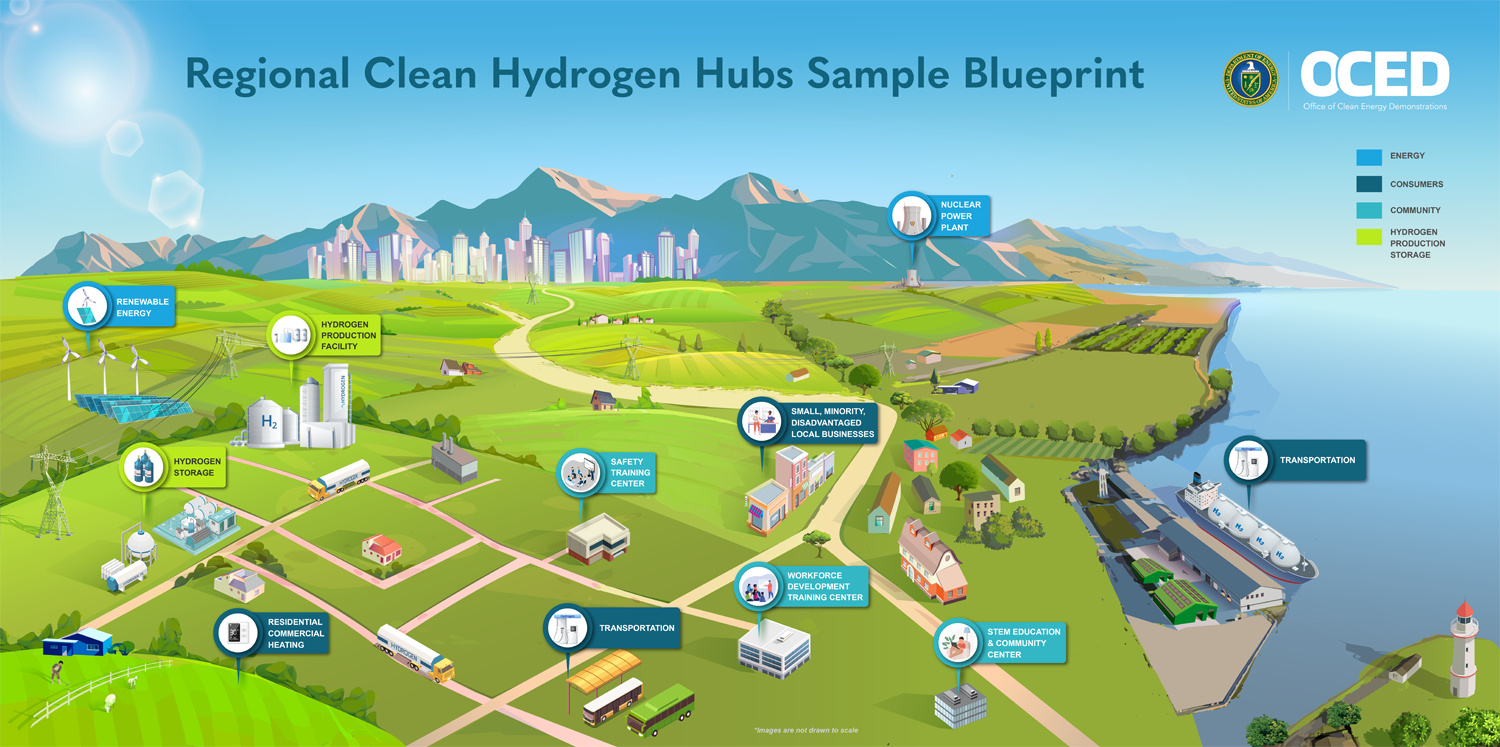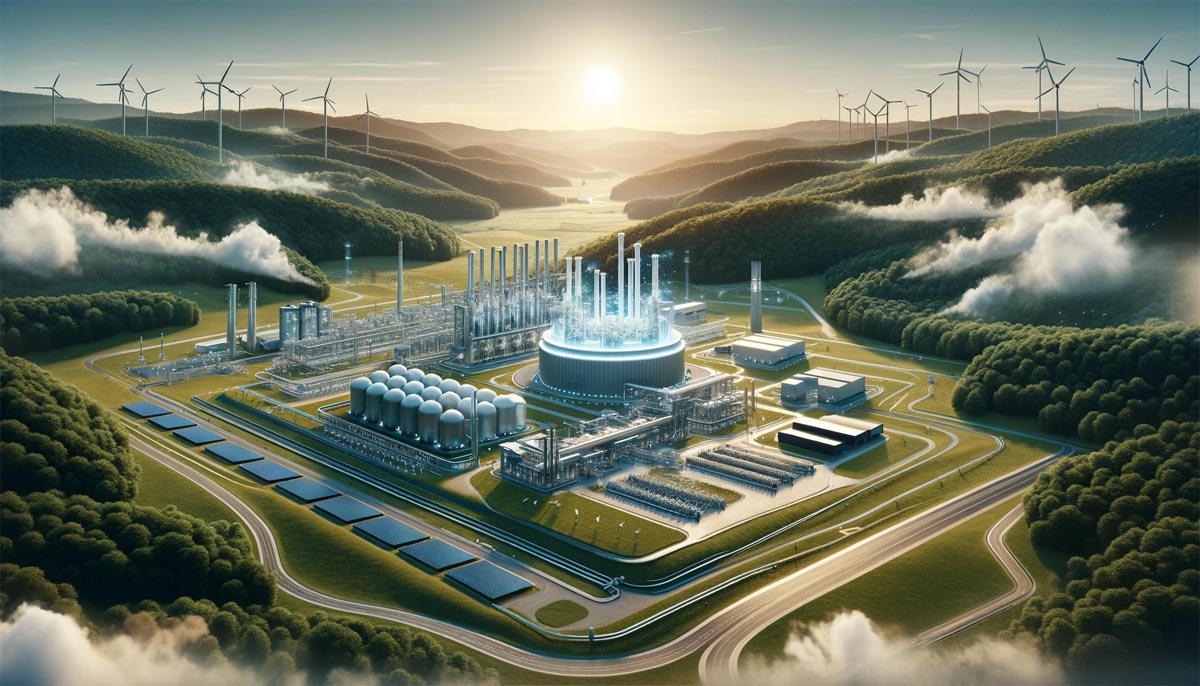Unveiling the Future of Energy with The Appalachian Regional Clean Hydrogen Hub
In an era where the quest for sustainable and clean energy solutions is paramount, the Appalachian Regional Clean Hydrogen Hub (ARCH2) emerges as a beacon of innovation and progress. At the heart of this transformative initiative lies the convergence of environmental stewardship and technological advancement, underscoring the region’s commitment to spearheading the nation’s energy evolution. The Hub, a visionary project aligning with President Biden’s ambitious environmental goals, aims to revolutionize the energy landscape by harnessing the potential of hydrogen – a resource poised to play a pivotal role in achieving a 100% clean electrical grid by 2035 and net-zero carbon emissions by 2050.
Contents
- 1 Unveiling the Future of Energy with The Appalachian Regional Clean Hydrogen Hub
- 1.1 Overview of Hydrogen Energy
- 1.2 What is a Hydrogen Hub?
- 1.3 Types of Hydrogen: Clean, Green, and Blue
- 1.4 The Appalachian Regional Clean Hydrogen Hub (ARCH2) Initiative
- 1.5 Hydrogen Production and Usage
- 1.6 The Regional Significance of the Appalachian Energy Future
- 1.7 Conclusion: Envisioning a Sustainable Future Through the Appalachian Hydrogen Hub

Hydrogen energy, colloquially known as “hydrogen power” or “hydrogen fuel,” represents a paradigm shift in our approach to energy production. This clean energy form, derived from hydrogen gas, leverages electricity from various sources to catalyze the splitting of water, thereby generating oxygen and hydrogen. Celebrated for its minimal carbon footprint, hydrogen energy stands at the forefront of low-carbon energy alternatives, offering a glimpse into a future defined by environmental sustainability and energy efficiency.
However, this path is not without its challenges and debates. Critics raise questions about the feasibility, economic viability, and environmental impacts of this significant pivot towards hydrogen energy production. These concerns underscore the need for a balanced and thorough exploration of hydrogen energy’s potential and limitations.
Central to the Appalachian Regional Clean Hydrogen Hub (ARCH2) is the concept of hydrogen hubs. These networks encompass a suite of facilities dedicated to the production, storage, distribution, and utilization of hydrogen as a dynamic energy source. Through an amalgamation of power plants, storage facilities, and pipelines, these hubs are not merely infrastructural projects but the foundational pillars of a national hydrogen facility network. The H2Hubs program, as envisioned by the Biden administration, is more than a mere energy project; it’s a symbol of America’s commitment to a cleaner, more sustainable future.
Diving deeper into the realm of hydrogen energy, it becomes evident that the term “clean hydrogen” is not a one-size-fits-all label. This term, widely used in policy and industry circles, encapsulates a variety of hydrogen production methods, each with its own environmental footprint. The most prevalent forms include green hydrogen, produced using renewable energy sources, and blue hydrogen, derived from natural gas in conjunction with carbon capture technologies. These color-coded classifications not only simplify the complex world of hydrogen production but also highlight the diverse pathways to achieving cleaner energy solutions.
As we embark on this journey through the Appalachian Regional Clean Hydrogen Hub (ARCH2), we will unravel the intricate tapestry of this groundbreaking initiative. From the creation of the Appalachian Regional Clean Hydrogen Hub (ARCH2) to the strategic significance of the Appalachian region in America’s energy narrative, this exploration is more than an academic discourse. It’s a narrative of hope, innovation, and a steadfast commitment to a future where energy is not just consumed but conscientiously and sustainably harnessed for the betterment of our planet and future generations.
Overview of Hydrogen Energy
Hydrogen energy stands at the forefront of the clean energy revolution, marking a significant shift in how we approach power generation and consumption. Often referred to as “hydrogen power” or “hydrogen fuel,” this form of energy is derived from hydrogen gas, a simple yet powerful element. The process of harnessing hydrogen energy is both innovative and intricate, involving the use of electricity from diverse sources to facilitate the splitting of water molecules. This process not only yields hydrogen but also produces oxygen as a byproduct, embodying a remarkable synergy of simplicity and efficiency.

The appeal of hydrogen energy lies in its minimal carbon emissions. Unlike traditional fossil fuels, which release significant amounts of carbon dioxide and other pollutants, hydrogen energy presents a cleaner alternative. This attribute aligns seamlessly with global efforts to mitigate climate change and reduce greenhouse gas emissions. In this context, hydrogen energy is not just an alternative but a key player in the quest for a sustainable and environmentally friendly energy future.
Despite its potential, hydrogen energy is not without its detractors. The pathway to a hydrogen-dominated energy landscape is fraught with challenges and uncertainties. Critics often voice concerns about the practicality and economic feasibility of large-scale hydrogen energy production. There are also environmental considerations, particularly regarding the methods used for hydrogen production and their respective carbon footprints. These concerns highlight the complexity of transitioning to hydrogen energy and underscore the need for a nuanced understanding of its potential and limitations.
In essence, hydrogen energy is more than a mere source of power; it represents a paradigm shift in our relationship with energy. It offers a glimpse into a future where our energy needs are met not at the expense of our planet but in harmony with it. As we delve deeper into the intricacies of hydrogen energy, it becomes clear that its role in shaping a sustainable future is both crucial and undeniable.
What is a Hydrogen Hub?
A hydrogen hub represents a groundbreaking concept in the realm of energy infrastructure, serving as a cornerstone in the transition towards a more sustainable energy ecosystem. These hubs are essentially networks of facilities that collectively focus on the production, storage, distribution, and utilization of hydrogen as a key energy source. Encompassing a range of infrastructures such as power plants, storage facilities, and pipelines, hydrogen hubs are more than mere physical constructs; they are the bedrock upon which the future of hydrogen-based energy is being built.
The inception of hydrogen hubs is a direct response to the increasing recognition of hydrogen’s potential as a clean energy source. The H2Hubs program, initiated by the federal government, is a strategic move towards establishing a comprehensive national network of hydrogen facilities and producers. This program is not just an infrastructure project; it’s a vision to integrate hydrogen energy into the nation’s energy matrix, thereby significantly contributing to the overarching goals of reducing carbon emissions and promoting clean energy usage.
At the heart of the hydrogen hub concept is the aspiration to make hydrogen an integral part of our energy landscape. By creating a system that supports the entire hydrogen energy lifecycle – from production to end-use – these hubs aim to facilitate the widespread adoption of hydrogen as a versatile and environmentally friendly energy source. The Biden administration’s support for these hubs underscores their significance in achieving the nation’s ambitious climate-related goals, positioning them as pivotal elements in the quest to transform America’s energy framework.
Hydrogen hubs, therefore, are more than just clusters of energy facilities; they are the epicenters of a burgeoning hydrogen economy. By fostering the production and utilization of hydrogen, these hubs are set to play a critical role in shaping a future where clean energy is not just a concept but a reality. As we explore the Appalachian Regional Clean Hydrogen Hub (ARCH2) in greater detail, the importance of these hubs in catalyzing a sustainable energy revolution becomes increasingly evident.
Types of Hydrogen: Clean, Green, and Blue
The world of hydrogen energy is as diverse as it is complex, characterized by various forms of hydrogen production, each distinct in its methodology and environmental impact. This diversity is often simplified into color-based categories, namely green, blue, and the broader term of clean hydrogen. Understanding these categories is essential in grasping the nuances of hydrogen as a sustainable energy source.
Clean Hydrogen: The term ‘clean hydrogen’ is widely utilized in discussions about hydrogen energy, often suggesting a form of hydrogen production with minimal environmental impact. However, this term is not bound to a single method of production. Instead, it serves as an umbrella term encompassing various low-carbon hydrogen production techniques. Clean hydrogen represents the broader goal of reducing carbon emissions in hydrogen production, regardless of the specific methodology employed. A good example of this would be the Heartland Hydrogen Hub.
Green Hydrogen: Green hydrogen, a term that has gained significant traction in recent years, refers specifically to hydrogen produced using renewable energy sources. This form of hydrogen production typically involves electrolysis, a process where water is split into hydrogen and oxygen using electricity generated from renewable sources like solar or wind power. Green hydrogen is lauded for its minimal environmental impact, as it largely eliminates the carbon emissions associated with the production process. A good example of this would be the California Hydrogen Hub.
Blue Hydrogen: In contrast to green hydrogen, blue hydrogen is produced from natural gas through processes such as steam methane reforming, where natural gas is combined with heated water to produce hydrogen and carbon dioxide. The distinguishing factor of blue hydrogen lies in its integration with carbon capture and storage (CCS) technologies. These technologies capture the carbon dioxide byproduct before it is released into the atmosphere, thereby reducing the environmental impact of hydrogen production.
The categorization of hydrogen into green, blue, and clean types provides a framework for understanding the various approaches to hydrogen production and their respective environmental footprints. As the Appalachian Regional Clean Hydrogen Hub (ARCH2) and similar initiatives continue to evolve, these distinctions play a crucial role in shaping policies and strategies aimed at harnessing hydrogen energy in the most sustainable manner possible.
The Appalachian Regional Clean Hydrogen Hub (ARCH2) Initiative
The Appalachian Regional Clean Hydrogen Hub, known as ARCH2, marks a significant milestone in the United States’ journey towards clean energy and sustainable industrial practices. In October 2023, this consortium, led by a collaborative team of experts and innovators, received recognition from the Department of Energy’s Office of Clean Energy Demonstrations. This selection was more than an accolade; it was a commitment to position Appalachia as a frontrunner in hydrogen-based solutions, setting a precedent for the nation.
the Appalachian Regional Clean Hydrogen Hub (ARCH2)’s mission is deeply rooted in the ethos of environmental sustainability and economic progress. The initiative aims to transform the Appalachian region into a powerhouse of hydrogen energy, utilizing the process of hydrogen capture, utilization, and storage. This transformative approach is poised to enhance local communities, foster job creation, reduce emissions, and combat climate change. The driving force behind this ambitious project is the collaborative synergy of various organizations, companies, non-profits, and other entities within the region, all united in their pursuit of a cleaner, more prosperous future.

Central to the Appalachian Regional Clean Hydrogen Hub (ARCH2)’s vision is the creation of a hydrogen ecosystem that is not only clean and efficient but also economically viable and socially equitable. This ecosystem spans multiple dimensions, including production, storage, delivery, and diverse end-use applications. the Appalachian Regional Clean Hydrogen Hub (ARCH2) plans to utilize the region’s abundant low-cost natural gas as the primary feedstock, propelling a regional hydrogen economy that spans multiple sectors. A key aspect of this vision is ensuring that the economic benefits of this new economy are distributed fairly and equitably among the local communities, ensuring that the prosperity brought by this initiative is shared by all.
In summary, the Appalachian Regional Clean Hydrogen Hub (ARCH2) initiative represents a bold step forward in redefining the region’s energy landscape. By leveraging its natural resources and the collective expertise of its participants, the Appalachian Regional Clean Hydrogen Hub (ARCH2) aims to establish Appalachia not only as a model for national hydrogen networks but also as a testament to the potential of clean energy to drive economic growth and environmental stewardship.
Hydrogen Production and Usage
Hydrogen, often celebrated as the most abundant chemical element in the universe, holds immense promise as a cornerstone of the future energy landscape. Its production process and usage present a fascinating blend of science, technology, and environmental stewardship.
Production Techniques: The most prevalent method of hydrogen production involves the interaction of natural gas with heated water through a process known as steam reforming. This chemical reaction splits natural gas into hydrogen and carbon dioxide, harnessing hydrogen’s high energy potential. The process of steam reforming is noteworthy for its efficiency, making it a widely adopted method in the current energy paradigm.
Notably, hydrogen’s unique properties, such as its high energy density – approximately three times that of crude oil – render it an exceptionally potent energy source. These characteristics make hydrogen an ideal candidate for a variety of applications, from fuel cells to industrial processes.

Decarbonization and Transition: Hydrogen’s role in the decarbonization of the economy is particularly significant. According to the U.S. Department of Energy, the vast majority of hydrogen is currently produced from natural gas, making it the most cost-effective and advanced method available. However, the integration of hydrogen into the energy mix offers more than just economic benefits; it represents a critical step in the transition towards a low-carbon future. Hydrogen can replace or supplement natural gas in many applications and, to some extent, be blended into existing pipeline networks as a low-carbon fuel option.
Regional Significance: In the context of the Appalachian region, hydrogen production and usage take on added significance. The region, home to one of the world’s largest natural gas basins, is uniquely positioned to lead in the hydrogen energy revolution. Leveraging its abundant natural gas reserves, the Appalachian region can catalyze the shift towards a cleaner energy future. This transition is not only about reducing emissions but also about driving economic growth and job creation in the tri-state area.
The use of Carbon Capture, Utilization, and Storage (CCUS) technologies in hydrogen production within the proposed ecosystem or hub further underscores the region’s commitment to sustainable practices. By integrating CCUS, the environmental impact of hydrogen production can be significantly mitigated, aligning with broader goals of climate change mitigation and sustainable development.
In summary, hydrogen production and usage in the Appalachian region represent a harmonious blend of economic opportunity and environmental responsibility. As the region embraces hydrogen energy, it sets the stage for a transformative journey towards a more sustainable and prosperous future.
The Regional Significance of the Appalachian Energy Future
The Appalachian region, with its rich natural resources and strategic geographic positioning, stands at the cusp of a transformative energy revolution. The development of the Appalachian Hydrogen Hub is more than just a regional initiative; it’s a pivotal chapter in the broader narrative of America’s energy future.
Strategic Natural Resources: At the core of this transformation is the Appalachian region’s abundant natural gas reserves. Home to one of the world’s largest natural gas basins, the region holds a key to unlocking the potential of hydrogen energy. The vast reserves of natural gas not only provide a primary feedstock for hydrogen production but also position the region as a crucial player in the national energy landscape.

Geographic Advantage: Geographically, the Appalachian region holds a significant advantage. Situated between the populous East Coast and the Great Lakes, the region serves as a vital link connecting major population centers. This strategic location offers an unparalleled opportunity to leverage industry clustering, facilitating economies of scale that can drive job growth and economic prosperity across the tri-state area.
Economic and Environmental Implications: The move towards hydrogen energy in the Appalachian region is not just an economic endeavor; it’s an environmental imperative. The region, while playing an essential role in the country’s energy production, also contributes significantly to emissions. The transition to a hydrogen-based economy offers a path to dramatically reduce these emissions, aligning with global efforts to combat climate change.
A Catalyst for Change: Moreover, the Appalachian Regional Clean Hydrogen Hub (ARCH2) is envisioned as a catalyst for industrial evolution, aligning with the broader goals of low-carbon and sustainable development. The integration of Carbon Capture, Utilization, and Storage (CCUS) technologies in hydrogen production exemplifies this commitment to environmental stewardship. These technologies not only minimize the carbon footprint of hydrogen production but also signify the region’s dedication to innovative and sustainable energy practices.
My Thoughts: In essence, the Appalachian region’s pivot towards hydrogen energy is more than just an economic strategy; it’s a testament to the region’s potential to lead America’s energy transformation. By harnessing its natural resources, strategic location, and technological advancements, the Appalachian region is poised to meet the nation’s energy needs while pioneering the transition to a more sustainable and low-carbon future.
Conclusion: Envisioning a Sustainable Future Through the Appalachian Hydrogen Hub
As we reflect on the extensive exploration of the Appalachian Regional Clean Hydrogen Hub (ARCH2) and its multifaceted dimensions, it becomes evident that this initiative is more than just an energy project. It represents a pivotal shift in our approach to sustainable energy and regional development. The Hub is a symbol of innovation, a testament to the potential of clean energy to drive economic growth, and a commitment to environmental stewardship.
The Appalachian Regional Clean Hydrogen Hub (ARCH2), with its focus on clean, green, and blue hydrogen, stands at the forefront of the energy transition. By harnessing the unique properties of hydrogen and leveraging advanced production technologies, the initiative is poised to transform the way we think about and use energy. The emphasis on clean hydrogen production methods, particularly through the utilization of the region’s abundant natural gas reserves, underscores a deep-seated commitment to reducing carbon emissions and combating climate change.
Moreover, the regional significance of this initiative cannot be overstated. The Appalachian region, with its vast natural resources and strategic geographical location, is uniquely positioned to lead the United States in this new energy era. The development of the Hydrogen Hub is expected to catalyze economic growth, create jobs, and foster a more sustainable industrial landscape, not just within the region but across the nation.
Furthermore, the integration of Carbon Capture, Utilization, and Storage (CCUS) technologies in hydrogen production is a clear indication of the region’s dedication to innovative and environmentally responsible energy practices. This approach not only mitigates the environmental impact of hydrogen production but also propels the region towards a cleaner and more sustainable future.
In conclusion, the Appalachian Regional Clean Hydrogen Hub (ARCH2) is more than an energy initiative; it is a beacon of hope and a blueprint for a sustainable future. It embodies a collective vision where economic prosperity, environmental responsibility, and technological innovation converge. As this initiative continues to unfold, it holds the promise of not only transforming the Appalachian region but also setting a precedent for sustainable energy development worldwide.


